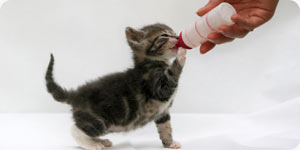
If you find a newborn kitten, the first step is to determine where its mom is. If the mother is not available, you’ll need to care for this newborn kitten yourself. However, if the mom is available, this is always preferable to human care for a baby kitten. If you are caring for a newborn kitten, one of the most challenging steps is feeding, because you’ll need to use a bottle. Here’s how to bottle-feed a newborn kitten:
Supplies:
- Kitten-sized bottle and nipple
- Kitten milk replacement (KMR)
- Pot of boiling water
- Towel
- Chair
- Paper towel or washcloth
Instructions:
- Purchase the right food. The best replacement milk is KMR, or kitten milk replacement, because it is specially formulated to be like a mother cat’s milk. If it’s an emergency situation, use milk for other animal species, baby formula meant for humans, or cow’s milk, although you should make the effort to get the right milk from the pet store, if you can. You can also purchase an appropriately sized bottle and nipple from the pet store. If you don’t have a small enough bottle, a large eye dropper can also work, but make sure not to drop too much milk into the kitten’s mouth at once.
- Prepare the feeding supplies. Mix the formula according to the instructions that came with it. Use a hot water bath for at least 5 minutes to sterilize both the bottle and the nipple. Let them cool before you use them. Warm the milk by placing the bottle or can in a bowl of hot water. It should be approximately body temperature; you can test it against the inside of your arm, like you would do for milk for a newborn child. When it’s the right temperature, pour it into the bottle and screw on the nipple. Make sure that the nipple is not clogged before trying to feed your kitten.
- Feed your kitten. Sit in the chair, with the towel draped over your lap. Make sure the kitten is warm, since feeding a cold kitten may cause digestive issues. Then place the kitten on its stomach on top of the towel. D not raise the kitten’s head, and place the bottle’s nipple in his mouth. Most kittens will know what to do from here. Let him nurse until the bottle is finished. If the kitten does not seem to nurse correctly, stroking his head or back can start his nursing reflexes.
- Care for the kitten after feeding. Wipe around their mouth if any formula has spilled. Then, burp the kitten by gently patting his upper back. Be gentle; too hard can make the kitten vomit. Then, you’ll need to stimulate the kitten’s bowels, which is something that the mother cat usually does. Rub the kitten’s genital area with a warm, damp washcloth or paper towel. Once your cat has defecated, allow your kitten to go to sleep.
- Repeat. You’ll need to bottle-feed a newborn kitten for about 10 to 20 minutes at a time, every few hours throughout the day and night. Many kittens will meow when they get hungry. Bottle feeding a kitten can be exhausting, but if the mother is unable to nurse your kitten, this is a necessary step to get the kitten the nutrition it needs. In total, each newborn kitten needs a little over an ounce of milk every day. If you have a whole litter of kittens, you may spend most of your day and night bottle feeding kittens.
Newborn kittens have the best chance for survival when they stay with their mothers. Never remove a kitten from its mother early just because you want to bottle feed it. Bottle feeding kittens can be fun, and it is a bonding experience, but you should not bottle feed newborn kittens by choice. Bottle feeding a newborn kitten should only be done if the mother is absent or too sick to care for her kitten.
